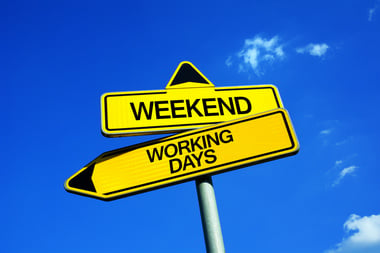How do you approach your day to be more productive? Do you catch yourself looking at the clock rather than focusing on what you’re getting done? When you put in less than eight or 10 hours of work, do you feel a bit guilty? This may be the wrong way to think — not just for you, but for your employees as well.
Perhaps we can stop thinking about working set hours. Some people prefer to work late into the night; some people enjoy starting work early in the day — we have different energy levels at different times.
There are occasions when you have to schedule time — meetings, for instance. But our work schedules are rarely managed by a set number of hours; instead, they’re guided by our energy levels.
Small-business owners often say, “Working set hours is typically the norm for full-time professionals. I count on the 40-hour work schedule.” Yes? Where did it come from? The Industrial Revolution. Factories needed to be running around the clock, so employees worked between 10- and 16-hour days. In the 1920s, Henry Ford decided to try something different. His workers would work only eight hours, five days a week.
He wanted to give employees enough free time to go out and buy stuff. “Leisure is an indispensable ingredient in a growing consumer market because working people need to have enough free time to find uses for consumer products, including automobiles.”
Does it make sense for us to track our work by required hours? We’ve moved from an economy based on industry to one based on information. So then, how should we schedule our days? What if we let our bodies schedule them for us?
Light and genetics are two main factors that help your body tell time. Light creates a natural cycle of energy levels; genetics causes your particular cycle to be longer or shorter. Your cycle may be a bit longer, and you may have more energy in the evening. Shorter cycles give you more energy in the morning.
A typical workday for business owners and work-for-yourselfers starts at 7 a.m. and ends around 5 p.m. Great for the early riser, but for those who prefer working nights, you’re often stuck slugging away when your energy levels are low. So how do you avoid the clock and work productively?
A Better Work Plan
Most of us don’t run factories, where rigid shift schedules are the norm. Depending on the kind of company you work in, below is a possible plan employees can use to manage their time:
- Write a realistic to-do list. Decide on three to four major tasks you want to get done. Plan for four to five hours of real work per day. This way, you’ll consistently complete your to-do list.
- Create cycles with your work. You probably have lots of different types of tasks to worry about. Try breaking up your day like this:
-
- A creative task first. Wake up and work on a creative task before you feel your concentration start to wane.
- An un-timed break. A 20-minute run, a nap, lunch — giving you a chance to refresh and regain mental power.
- A mundane task. Bulk these together to save time. Check all your emails or schedule multiple phone calls in a row. When you switch back to a creative task, you won’t have the cloud of a hundred emails hovering over your head.
- Another un-timed break.
- Find a true metric to measure your task. Come up with a true goal for what you’re producing. Maybe you should track the sales that result from each blog post you write, rather than the number of posts you write, for example.
The important thing to remember is that it’s not about the number of hours you work, but what you do in those hours that counts.
Of course, every company is different, and some need more structure than others. But think of how different metrics and different ways of working can not only free your employees from rigid time policies, but even make your company more profitable. Questions? Give us a call.






